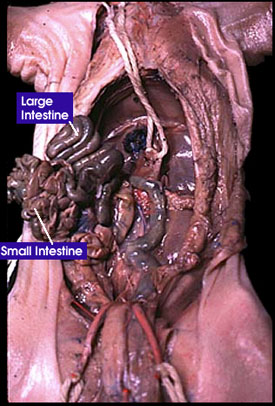Rectum, pancreas
 Reflecting the small intestine and most of the large intestine to the pig's right allows us to see the rectum and the pancreas.
Reflecting the small intestine and most of the large intestine to the pig's right allows us to see the rectum and the pancreas.
The rectum is the distal-most section of the large intestine and forms and stores feces.
The exocrine pancreas produces enzymes used to chemically digest food. These enzymes exit the pancreatic duct and enter the duodenum of the small intestine via the common bile duct. The endocrine pancreas produces hormones -- insulin and glucagon -- that control the level of glucose in the blood. These hormones exit the pancreas via the circulation.
This photo also clearly shows the umbilical arteries (tied with string lower edge of photo).
In utero, the umbilical arteries carry de-oxygenated blood and metabolic waste products away from the fetus to the placenta. From there the waste products and carbon dioxide diffuse to the mother's blood and are then cleared from her body.
In utero, oxygen and nutrients from the mother's arterial blood diffuse into the fetal blood of the placenta and are carried to the fetus via the umbilical vein (not shown).
Next: Mesentery
Back to: Digestive system